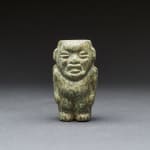Olmecoid Green Stone Janus Dwarf Figure, 900 BCE - 400 BCE
height 5.7 cm
height 2 1/4 in
height 2 1/4 in
SP.174
Further images
The Olmec were an ancient Pre-Columbian people living in the tropical lowlands of south-central Mexico, roughly in what are the modern-day states of Veracruz and Tabasco on the Isthmus of...
The Olmec were an ancient Pre-Columbian people living in the tropical lowlands of south-central Mexico, roughly in what are the modern-day states of Veracruz and Tabasco on the Isthmus of Tehuantepec. Their immediate cultural influence, however, extends beyond this region (Olmec artwork has been documented as far as El Salvador). The Olmec flourished during the Formative (or Preclassic), dating from 1200 BCE to about 400 BCE, and are believed to have been the progenitor civilization of later Mesoamerican civilizations. Olmec artforms remain in works of both monumental statuary and small jadework. Much Olmec art is highly stylized and uses an iconography reflective of a religious meaning to the artworks. Some Olmec art, however, is surprisingly naturalistic, displaying an accuracy of depiction of human anatomy perhaps equaled in the pre-Columbian New World only by the best Maya Classic era art. Common motifs include downturned mouths and slit-like slanting eyes, both of which can be seen as representations of "were-jaguars". Olmec figurines are also found abundantly in sites throughout the Formative Period.





